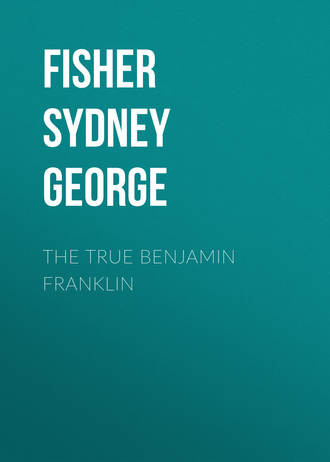 полная версия
полная версияThe True Benjamin Franklin
The letters that come nearest to what the reviewer wants are those to Miss Mary Stevenson. There are quite a number of them, and she and Franklin were on the most affectionate terms. We will give the citations of them in Bigelow, although any one can look them up in the index: In vol. iii. pp. 34, 46, 54, 56, 62, 139, 151, 186, 187, 195, 209, 232, 238, 245; in vol. iv. pp. 17, 33, 212, 258, 264, 287, 332, 339; in vol. x. p. 285. These letters call Miss Stevenson “Dear Polly,” “My dear friend,” “My good girl,” and “My dear good girl.” The first of them, vol. iii. p. 34, begins by addressing her as “dear child,” and another, vol. iii. p. 209, closes by saying “Adieu my dear child. I will call you so. Why should I not call you so, since I love you with all the tenderness of a father.”
This may be what the reviewer had in his mind. But Franklin nowhere calls Miss Stevenson his daughter. The word daughter and child are very different. We all of us often call children we fancy “my child.” Franklin’s use of the word child as applied to Miss Stevenson has from the context of the letters a perfectly obvious meaning, – no one can mistake it; just as his use of the word daughter in the Foxcroft letters has, from the context and all the circumstances, a perfectly obvious meaning.
It would be endless to discuss all the reviewer’s irrelevant and extravagant statements. We shall call attention to only one other illustration of his methods. He closes one of his wild paragraphs by saying that if “Mr. Fisher wishes further knowledge on this subject for ‘speculation,’ we recommend him to read Franklin’s letter to Foxcroft of September 7, 1774.”
The reviewer is careful not to quote from this letter or even to say where it may be found, and the inference the ordinary reader would draw from the way it is paraded is that it contains some very positive denial that Mrs. Foxcroft was Franklin’s daughter. But when it is examined, it is found to be a business letter like the others, referring to the lady in question as “Mrs. Foxcroft” instead of as “my daughter,” a perfectly natural way of referring to her and entirely consistent with the other letters. We give the letter in full. It is in the American Philosophical Society Collection, vol. xlv., No. 94:
London Sept. 7, 1774.Mr. Foxcroft,
Dear Friend —
Mr. Todd called to see me yesterday. I perceive there is good deal of uneasiness at the office concerning the Delay of the Accounts. He sent me in the Evening to read and return to him a Letter he had written to you for the Mail. Friendship requires me to urge earnestly your Attention to the contents, if you value the Continuance of your Appointment; for these are times of uncertainty, and I think it not unlikely that there is some Person in view ready to step into your Shoes, if a tolerable reason could be given for dismissing you. Mr. Todd is undoubtedly your Friend. But everything is not always done as he would have it This to yourself; and I confide that you will take it as I mean it for your Good.
Several Packets are arrived since I have had a Line from you. But I had the pleasure of seeing by yours to Mr. Todd that you and Mrs. Foxcroft with your little Girl are all in good Health which I pray may continue.
I am ever my dear old friendYours most affectionately B. Franklin.1
Vol. iv. p. 271.
2
Pennsylvania: Colony and Commonwealth, p. 80.
3
Pennsylvania: Colony and Commonwealth, p. 141.
4
Pennsylvania: Colony and Commonwealth, pp. 374-377, 381.
5
Men, Women, and Manners in Colonial Times, vol. i. p. 210.
6
Men, Women, and Manners in Colonial Times, vol. i. p. 222.
7
Bigelow’s Works of Franklin, vol. i. p. 180.
8
Bigelow’s Works of Franklin, vol. v. p. 209.
9
H. W. Smith’s Life of Rev. William Smith, vol. ii. p. 174.
10
Some years afterwards, when he had become prosperous, he restored the money to Mr. Vernon, with interest to date.
11
Vol. v. p. 201.
12
Bigelow’s Works of Franklin, vol. iii. p. 216, note.
13
This verse Franklin also quotes against Smith in a letter to Miss Stevenson. (Bigelow’s Works of Franklin, vol. iii. p. 235.)
14
Bigelow’s Works of Franklin, vol. vii. p. 374.
15
Pp. 209-217.
16
Bigelow’s Franklin from His Own Writings, vol. ii. p. 511.
17
Bigelow’s Works of Franklin, vol. v. p. 376; also vol. x. p. 78; Adams’s Works, vol. i. p. 659.
18
Making of Pennsylvania, chap. ix.
19
Pillsbury’s Gulf Stream, published by the U. S. government.
20
Bigelow’s Works of Franklin, vol. ii. p. 331; vol. ix. p. 185.
21
Pennsylvania: Colony and Commonwealth, p. 147.
22
Bigelow’s Works of Franklin, vol. vi. p. 300.
23
Pennsylvania: Colony and Commonwealth, p. 221.
24
Pennsylvania: Colony and Commonwealth, chap. xix.
25
Bigelow’s Works of Franklin, vol. iii. p. 212; vol. x. pp. 295, 302.
26
Pennsylvania: Colony and Commonwealth, p. 314.
27
Hosmer’s Life of Samuel Adams, p. 117.
28
By his will Franklin left this picture to his daughter, Sarah Bache, and it is still in the possession of her descendants. He requested her not to use the outer circle of diamonds as ornaments and introduce the useless fashion of wearing jewels in America, but he implied that she could sell them. She sold them, and with the proceeds she and her husband made the tour of Europe. The inner circle he directed should be preserved with the picture, but they were removed.
29
Pp. 218, 231-236.



